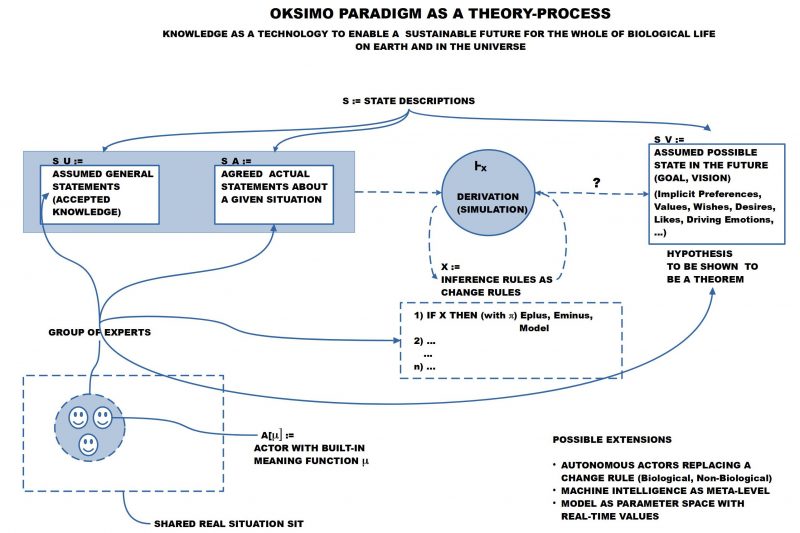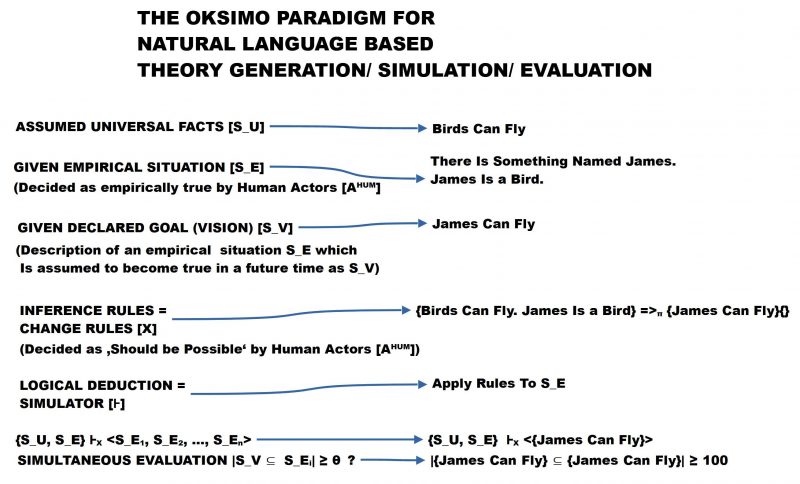eJournal: uffmm.org
ISSN 2567-6458, 5.April – 5.April 2021
Email: info@uffmm.org
Author: Gerd Doeben-Henisch
Email: gerd@doeben-henisch.de
Last changes: Small corrections, April 8, 2021
CONTEXT
This text is part of a philosophy of science analysis of the case of the oksimo software (oksimo.com). A specification of the oksimo software from an engineering point of view can be found in four consecutive posts dedicated to the HMI-Analysis for this software.
THE GENERALIZED OKSIMO THEORY PARADIGM

In the preceding sections it has been shown that the oksimo paradigm is principally fitting in the theory paradigm as it has been discussed by Popper. This is possible because some of the concepts used by Popper have been re-interpreted by re-analyzing the functioning of the symbolic dimension. All the requirements of Popper could be shown to work but now even in a more extended way.
SUSTAINABLE FUTURE
To describe the oksimo paradigm it is not necessary to mention as a wider context the general perspective of sustainability as described by the United Nations [UN][1]. But if one understands the oksiomo paradigm deeper and one knows that from the 17 sustainable development goals [SDGs] the fourth goal [SDG4] is understood by the UN as the central key for the development of all the other SDGs [2], then one can understand this as an invitation to think about that kind of knowledge which could be the ‘kernel technology’ for sustainability. A ‘technology’ is not simply ‘knowledge’, it is a process which enables the participants — here assumed as human actors with built-in meaning functions — to share their experience of the world and as well their hopes, their wishes, their dreams to become true in a reachable future. To be ‘sustainable’ these visions have to be realized in a fashion which keeps the whole of biological life alive on earth as well in the whole universe. Biological life is the highest known value with which the universe is gifted.
Knowledge as a kernel technology for a sustainable future of the whole biological life has to be a process where all human biological life-forms headed by the human actors have to contribute with their experience and capabilities to find those possible future states (visions, goals, …) which can really enable a sustainable future.
THE SYMBOLIC DIMENSION
To enable different isolated brains in different bodies to ‘cooperate’ and thereby to ‘coordinate’ their experience, and their behavior, the only and most effective way to do this is known as ‘symbolic communication’: using expressions of some ordinary language whose ‘meaning’ has been learned by every member of the population beginning with being born on this planet. Human actors (classified as the life-form ‘homo sapiens’) have the most known elaborated language capability by being able to associate all kinds of experience with expressions of an ordinary language. These ‘mappings’ between expressions and the general experience is taking place ‘inside the brain’ and these mappings are highly ‘adaptive’; they can change over time and they are mostly ‘synchronized’ with the mappings taking place in other brains. Such a mapping is here called a ‘meaning function’ [μ].
DIFFERENT KINDS OF EXPRESSIONS
The different sientific disciplines today have developed many different views and models how to describe the symbolic dimension, their ‘parts’, their functioning. Here we assume only three different kinds of expressions which can be analayzed further with nearly infinite many details.
True Concrete Expressions [S_A]
The ‘everyday case’ occurs if human actors share a real actual situation and they use their symbolic expressions to ‘talk about’ the shared situation, telling each other what is given according to their understanding using their built-in meaning function μ. With regard to the shared knowledge and language these human actors can decide, wether an expression E used in the description is matching the observed situation or not. If the expression is matching than such an expression is classified as being a ‘true expression’. Otherwise it is either undefined or eventually ‘false’ if it ‘contradicts’ directly. Thus the set of all expressions assumed to be true in a actual given situation S is named here S_A. Let us look to an example: Peter says, “it is raining”, and Jenny says “it is not raining”. If all would agree, that it is raining, then Peters expression is classified as ‘true’ and Jennys expression as ‘false’. If different views would exist in the group, then it is not clear what is true or false or undefined in this group! This problem belongs to the pragmatic dimension of communication, where human actors have to find a way to clarify their views of the world. The right view of the situation depends from the different individual views located in the individual brains and these views can be wrong. There exists no automatic procedure to get a ‘true’ vision of the real world.
General Assumptions [S_U]
It is typical for human actors that they are collecting knowledge about the world including general assumptions like “Birds can fly”, “Ice is melting in the sun”, “In certain cases the covid19-virus can bring people to death”, etc. These expressions are usually understood as ‘general’ rules because they do not describe a concrete single case but are speaking of many possible cases. Such a general rule can be used within some logical deduction as demonstrated by the classical greek logic: ‘IF it is true that “Birds can fly” AND we have a certain fact “R2D2 is a bird” THEN we can deduce the fact “R2D2 can fly”‘. The expression “R2D2 can fly” claims to be true. Whether this is ‘really’ the case has to be shown in a real situation, either actually or at some point in the future. The set of all assumed general assumptions is named here S_U.
Possible Future States [S_V]
By experience and some ‘creative’ thinking human actors can imagine concrete situations, which are not yet actually given but which are assumed to be ‘possible’; the possibility can be interpreted as some ‘future’ situation. If a real situation would be reached which includes the envisioned state then one could say that the vision has become ‘true’. Otherwise the envisioned state is ‘undefined’: perhaps it can become true or not. In human culture there exist many visions since hundreds or even thousands of years where still people are ‘believing’ that they will become ‘true’ some day. The set of all expressions related to a vision is named here S_V.
REALIZING FUTURE [X, ⊢X]
If the set of expressions S_V related to a ‘vision’ (accompanied by many emotions, desires, details of all kinds) is not empty, then it is possible to look for those ‘actions’ which with highest ‘probability’ π can ‘change’ a given situation S_A in a way that the new situation S’ is becoming more and more similar to the envisioned situation S_V. Thus a given goal (=vision) can inspire a ‘construction process’ which is typical for all kinds of engineering and creative thinking. The general format of an expression to describe a change is within the oksimo paradigm assumed as follows:
- With regard to a given situation S
- Check whether a certain set of expressions COND is a subset of the expressions of S
- If this is the case then with probability π:
- Remove all expressions of the set Eminus from S,
- Add all expressions of the set Eplus to S
- and update (compute) all parameters of the set Model
In a short format:
S’π = S – Eminus + Eplus & MODEL(S)
All change rules together represent the set X. In the general theory paradigm the change rules X represent the inference rules, which together with a general ‘inference concept’ ⊢X constitute the ‘logic’ of the theory. This enables the following general logical relation:
{S_U, S_A} ⊢X <S_A, S1, S2, …, Sn>
with the continuous evaluation: |S_V ⊆ Si| > θ. During the whole construction it is possible to evaluate each individual state whether the expressions of the vision state S_V are part of the actual state Si and to which degree.
Such a logical deduction concept is called a ‘simulation’ by using a ‘simulator’ to repeat the individual deductions.
POSSIBLE EXTENSIONS
The above outlined oksimo theory paradigm can easily be extended by some more features:
- AUTONOMOUS ACTORS: The change rules X so far are ‘static’ rules. But we know from everyday life that there are many dynamic sources around which can cause some change, especially biological and non-biological actors. Every such actors can be understood as an input-output system with an adaptive ‘behavior function’ φ. Such a behavior can not be modeled by ‘static’ rules alone. Therefore one can either define theoretical models of such ‘autonomous’ actors with their behavior and enlarge the set of change rules X with ‘autonomous change rules’ Xa as Xa ⊆ X. The other variant is to include in real time ‘living autonomous’ actors as ‘players’ having the role of an ‘autonomous’ rule and being enabled to act according to their ‘will’.
- MACHINE INTELLIGENCE: To run a simulation will always give only ‘one path’ P in the space of possible states. Usually there would be many more paths which can lead to a goal state S_V and the accompanying parameters from Model can be different: more or less energy consumption, more or less financial losses, more or less time needed, etc. To improve the knowledge about the ‘good candidates’ in the possible state space one can introduce general machine intelligence algorithms to evaluate the state space and make proposals.
- REAL-TIME PARAMETERS: The parameters of Model can be connected online with real measurements in near real-time. This would allow to use the collected knowledge to ‘monitor’ real processes in the world and based on the collected knowledge recommend actions to react to some states.
COMMENTS
[1] The 2030 Agenda for Sustainable Development, adopted by all United Nations Member States in 2015, provides a shared blueprint for peace and prosperity for people and the planet, now and into the future. At its heart are the 17 Sustainable Development Goals (SDGs), which are an urgent call for action by all countries – developed and developing – in a global partnership. They recognize that ending poverty and other deprivations must go hand-in-hand with strategies that improve health and education, reduce inequality, and spur economic growth – all while tackling climate change and working to preserve our oceans and forests. See PDF: https://sdgs.un.org/sites/default/files/publication/21252030%20Agenda%20for%20Sustainable%20Development%20web.pdf
[2] UN, SDG4, PDF, Argumentation why the SDG4 ist fundamental for all other SDGs: https://sdgs.un.org/sites/default/files/publications/2275sdbeginswitheducation.pdf

